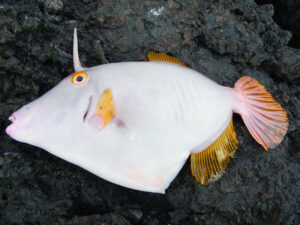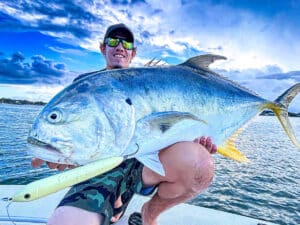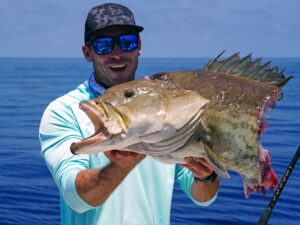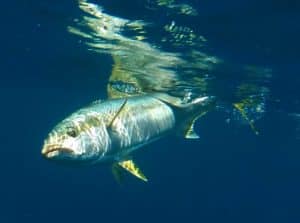Freaky Floater
QUESTION:
I found this fish floating 10 miles offshore in the Pacific off the Golfo Dulce, southern Costa Rica. Is it some sort of sea robin?
Cory Craig, Costa Rica
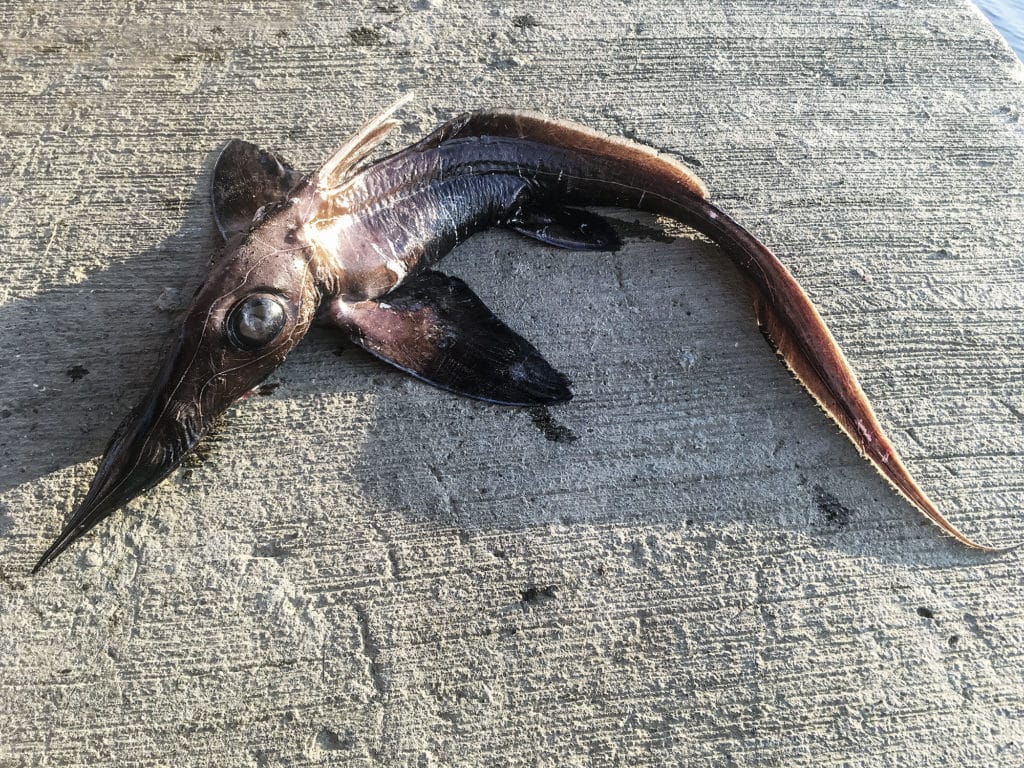
ANSWER:
Hey, Cory — that truly remarkable fish is a deepwater longnose chimaera, Harriota raleighana. Found in the eastern Pacific from Southern California to Peru and throughout the world, these fish live at depths of 1,100 to 8,500 feet, and reach a length of 47 inches. Like other chimaerids (also known as ratfishes), this species has a long spine near the front of its dorsal fin that is likely at least mildly venomous. Males have a little clublike structure (a tenaculum) atop their head with a tip covered in small, sharp spines. In at least one other chimaerid (and so perhaps in all of them), the male uses the spines to hold a female’s pectoral fin in place during mating. Among living fishes, chimaerids are most closely related to the cartilaginous fishes (sharks, skates and rays), and like them can detect electric fields, a sense they probably use to find prey living under the seafloor. Living in deep water means that longnose chimaerids are rarely, if ever, taken by recreational anglers (one would need a really fast-sinking wet fly), but they are an occasional bycatch in commercial trawl and hook-and-line fisheries.
—Milton Love
Not Fit for a Pig
QUESTION:
I caught this flatfish in my crab pot. I’ve fished Barnegat Bay my whole life but have never seen a flatfish like this before. Could you please help us with an ID?
Chris Moretta, Ortley Beach, New Jersey
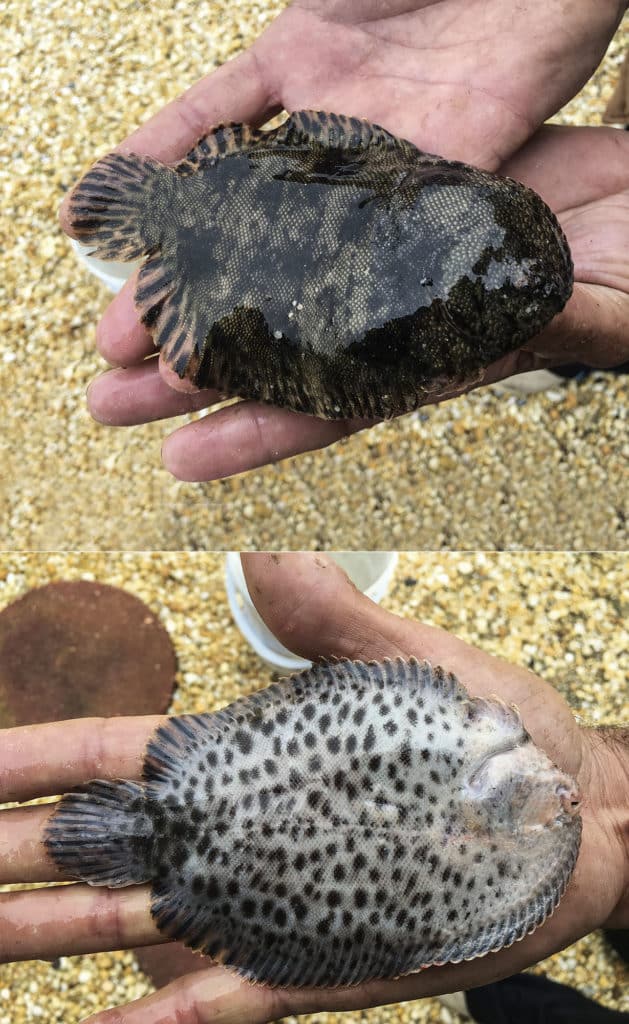
ANSWER:
Chris, your flatfish is a hogchoker, Trinectes maculatus. It’s a dark member of the sole family, Soleidae, usually showing a series of darker bars, stripes or blotches crossing its body on the eyed side. Often, the blind side also has spots or blotches, unusual among flatfishes. It has tiny eyes on the right side of the head, and a very small, asymmetrical mouth. The hogchoker lacks a pectoral fin. Its distribution extends from Massachusetts to Venezuela, and it’s one of the few soles found off the Middle Atlantic states. Mainly a coastal ocean or estuarine fish, the hogchoker also occurs in fresh water, sometimes quite far upstream.
That common name demands an explanation. The authors of Fishes of Chesapeake Bay (Hildebrand & Schroeder, 1928) are the source of the widely accepted rumor that hogchokers got their name because hogs that “feed on fish discarded on the beaches have difficulty in swallowing the sole because of its extremely hard, rough scales.” Seems reasonable.
—Mike Fahay
Toothy Vintage Tuna
QUESTION:
My uncle, Roger Marron, a 95-year‑old Pearl Harbor survivor, is pictured holding the fishing rod in 1941 before the Pearl Harbor attack. The two fish were caught between Hawaii and Midway from Navy repair ship USS Medusa. They appear to me to be tuna of some type? A lifelong fisherman, Uncle Roger would be very happy to learn more about his fish.
Charlene Fisher, Costa Mesa, California
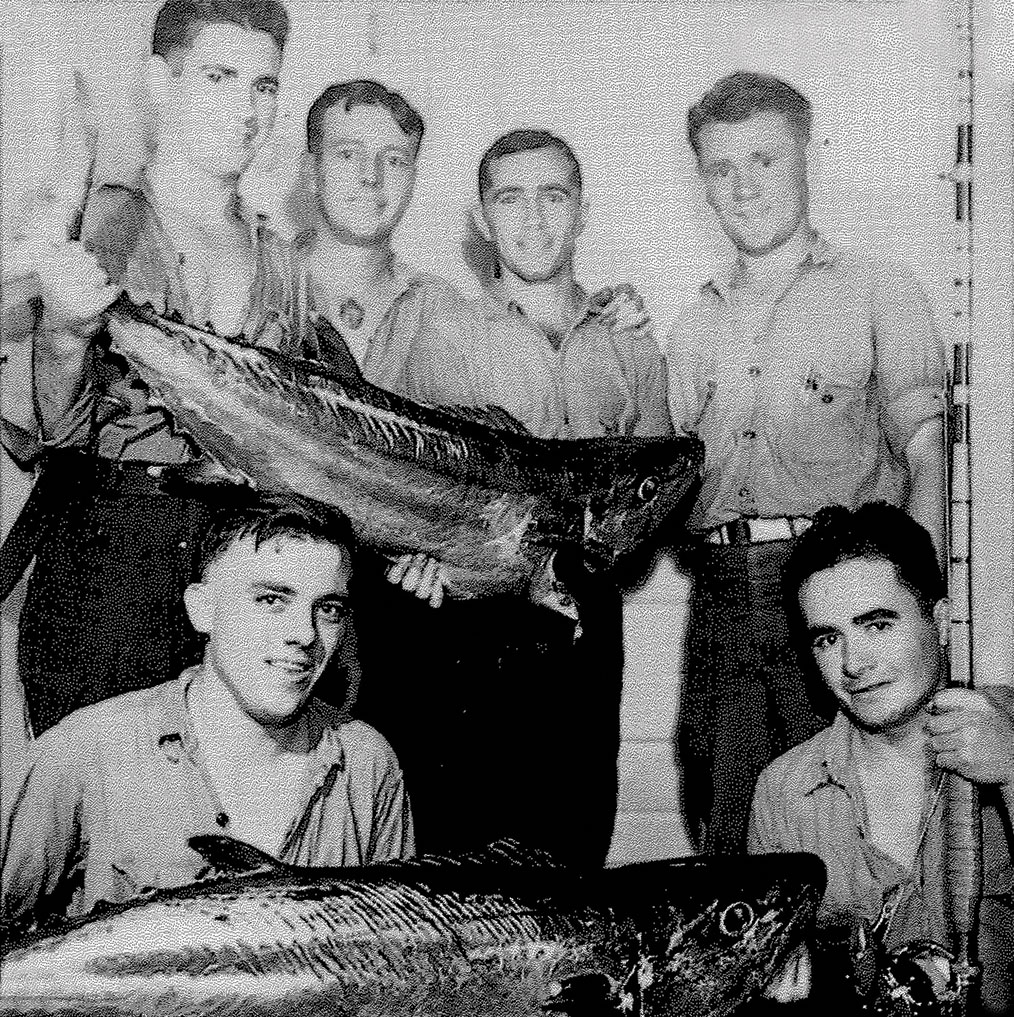
ANSWER:
Hi, Charlene, and thanks to Uncle Roger for the classic picture of what are undoubtedly dogtooth tuna (Gymnosarda unicolor). These fish are found patrolling deep drop-offs in depths up to 350 feet around oceanic coral reefs and atolls in the Indian and Western Pacific oceans, as well as in the Red Sea. They have been recorded in scientific literature from Guam and the northern Marianas Islands but not from Hawaii, so the locations you mention are farther east than the “official” distribution of this species. The dogtooth is an interesting species for many reasons, not the least because it’s more closely related to bonitos rather than the “true” tropical tunas such as yellowfin and skipjack.
Indeed, dogtooth are the largest of the bonitos, growing to over 8 feet long and in excess of 250 pounds. They are conspicuous among bonitos (and most tunas) because they possess a large swim bladder, which can sometimes cause barotrauma problems when released boatside. The dogtooth’s name is derived from its impressive array of caninelike conical teeth. In an evolutionary sense, these teeth — designed for holding prey — hint at the intermediate position of the bonitos, which lie between the lethal cutting dentistry of the mackerels (such as wahoo) and the scarcely toothed tunas. Of course, their teeth also suggest that dogtooth are fierce predators, mainly of reef-associated, schooling species such as fusiliers and rainbow runners. Because of this, dogtooth are unusual as a tuna species recognized to carry ciguatera toxin in some locations.
Observations by divers suggest that adult dogtooth patrol areas of deep reef edge but also might frequent certain high-current locations adjacent to structure such as large coral outcrops. The presence of the large swim bladder suggests that in these circumstances, dogtooth might be able to hold station in the current and act as ambush predators, in stark contrast to most highly mobile tunas and bonitos, which spend their time actively pursuing prey. Because of this affinity for structure, their large growth potential, and tuna-like swimming abilities, large dogtooth are extremely difficult to extract from their chosen haunts using sport-fishing gear.
— Ben Diggles
Catch My Drift(fish)
QUESTION:
While bottomfishing off Kona’s Honokohau Harbor, we pulled up this fish from about 100 fathoms. It was really slimy and something we haven’t seen before. What can you tell us about it?
Wesley Murakane, Kailua-Kona, Hawaii
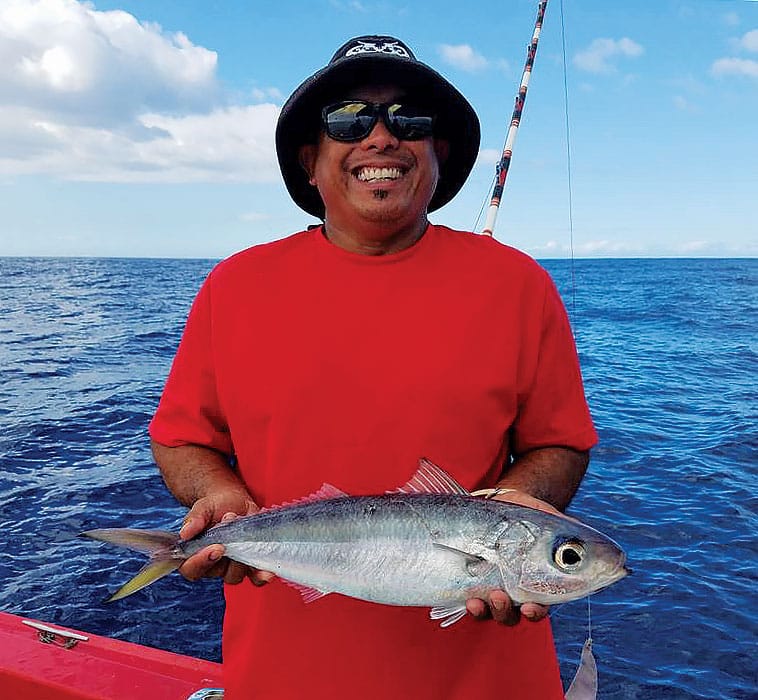
ANSWER:
That, Wesley, appears to be a nice specimen of a bigeye cigarfish (Cubiceps pauciradiatus). Without more information, such as counts of fin rays and gill rakers, I can’t be positive it isn’t a closely related species, Ariomma brevimanus. But we’ll go with the most likely candidate here, the cigarfish. A member of the family Nomeidae (driftfishes), cigarfish spend their early lives drifting under floating objects, particularly jellyfish or sargassum clumps, before heading for deeper waters as they mature. Members of the driftfish group feed mainly on jellyfish, salps and zooplankton. Even though they might feed on squid as well, anglers rarely catch them. Some of the more-specialized driftfishes, such as the aptly named man-o-war fish (Nomeus gronovii), spend their early lives under a particular species of floating jellyfish, feeding on its tentacles and any suitable food objects that drift by. However, the bigeye cigarfish (also known as Evermanns nomeid) moves to deeper waters once it matures, moving between depths of 600 to 1,000 feet during the day to within 150 feet of the surface at night, feeding on salps and vertically migrating plankton. Perhaps because of their proportionally larger eyes, this species is the deepest of the 16 species of driftfishes, recorded to depths of 3,000 feet. Bigeye cigarfish, found worldwide in tropical waters, grow to around 5 pounds. You could submit your next catch of a cigarfish to the IGFA and claim an all-tackle world record since the species thus far is unrepresented. C. pauciradiatus is to be a major prey item for tunas, billfishes and marine mammals. —Ben Diggles
Lion Tamer
QUESTION:
I caught this lionfish while jigging off Trinidad. It weighed 3½ pounds, and I’m wondering how large lionfishes grow. Which species is the largest?
Stuart Hutton, Trinidad
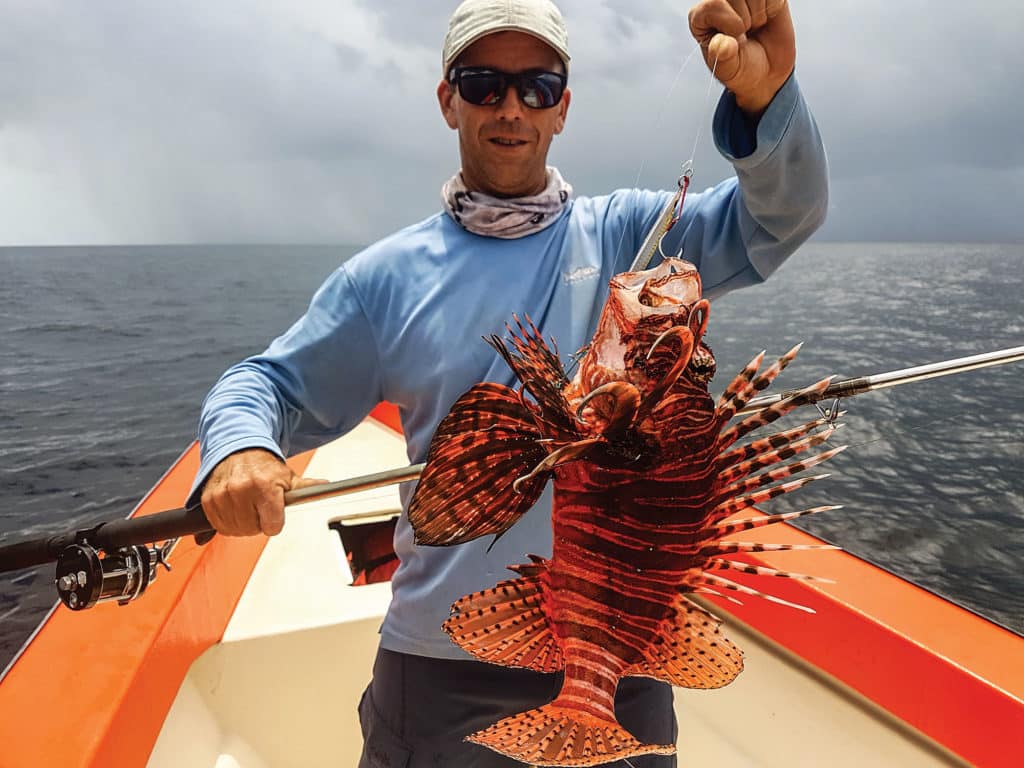
ANSWER:
That’s definitely a very large lionfish, Stuart. Based on the number of anal-fin rays (seven), your catch is a red lionfish, Pterois volitans, rather than the very similar devil firefish, P. miles, a second lionfish species that has been introduced to and established in the central western Atlantic. The red lionfish is native to the Pacific and portions of the Indian Ocean; P. miles also inhabits portions of the Indian Ocean, including the Persian Gulf and Red Sea. The largest record I’ve found for red lionfish is one speared in Florida that measured slightly over 19 inches, which might be close to the maximum size attained by this species. This makes the red lionfish one of the largest, if not the largest, of all lionfishes. The International Game Fish Association lists the all-tackle record for red lionfish as 2.2 pounds; since your fish exceeded this weight, it was a potential IGFA record. Much of the popular literature surrounding lionfishes has focused on the fishes’ 13 venomous dorsal spines, but the two pelvic spines and three anal spines can also deliver a painful sting. Heat, usually applied in the form of hot water, can denature the proteins in the venom and help alleviate the intense pain that often accompanies a wound. Possessing white, flaky flesh, the red lionfish makes excellent table fare, but those venomous spines require caution when cleaning lionfishes. To avoid accidental punctures, a person cleaning a lionfish should clip the fish’s fin spines with stout scissors. Some anglers/spearfishers thoroughly heat the fins with a propane torch so if they are punctured by fin spines, envenomation doesn’t occur. Lionfishes are attracted to movement and seldom eat static prey. For this reason, they aren’t often caught by anglers fishing with cut bait on the bottom. Using a moving bait such as the vertical jig that resulted in your catch is ideal, as long as the lure is placed correctly and moves slowly enough so a lionfish can catch it.
—Ray Waldner
Read Next: Strange Fishes From the Deep — Flapnose Catfish and More
Sport Fishing‘s International Panel of Experts, Past and Present
- Northeast: Mike Fahay, Sandy Hook Marine Lab, New Jersey
- Southeast: Ray Waldner, Ph.D., Palm Beach Atlantic University, Florida
- Gulf of Mexico: Bob Shipp, Ph.D., University of South Alabama
- West Coast: Milton Love, Ph.D., UCSB, California
- Far Pacific: Ben Diggles, Ph.D., Queensland, Australia
- Bluewater Pelagics: John Graves, Ph.D., Virginia Institute of Marine Science

